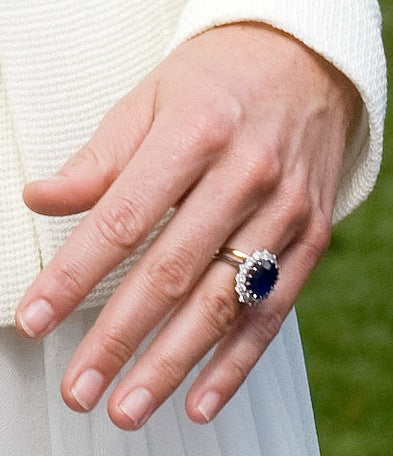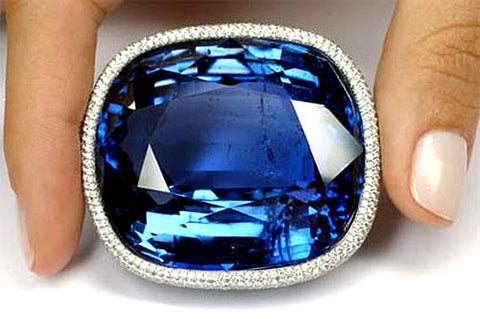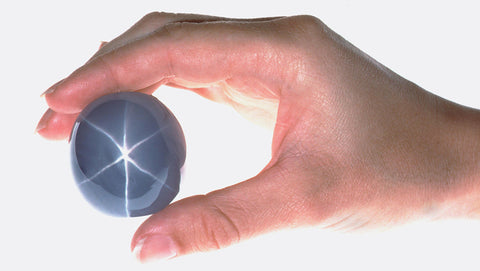September babies…wear your blue sapphire birthstone and find your peace.
Had your wisdom teeth pulled and missing them?
Want to protect your loved ones from harm?
September's blue sapphire birthstone is here to save the day!
- Sapphire healing energies can protect you from diseases, poison, ill wishes and even black magic (whew!).
- Sapphire uncovers deceit and fraud.
- They can also help preserve a person's chastity (WHAAAA?).
- The energies of tumbled sapphire enhance your level of concentration (lookout Rx companies).
- Did you know September’s birthstone comes in a variety of colors?
- Known as the "wisdom stone", each color of sapphire brings its own wisdom. It releases mental tension, depression, unwanted thoughts and spiritual confusion. Sign me up. Sapphire, bring it on....
Dignity |
Faith |
Loyalty (true blue!) |
Purity |
Serenity |
Luck |

Blue, violet, green, yellow, orange, pink and purple
Red corundum varieties are called rubies.
Then there is the cool geek-squad info about sapphire!
| The coloring agents in blue sapphires are iron and titanium. | Chrome in corundum colors it pink. |
| Violet stones contain vanadium. | Iron and vanadium manifest orange tones. |
| Iron content results in yellow and green sapphires. | Star or cat’s eye sapphires have inclusions of aligned rutile (needlelike crystals of titanium dioxide). |
How durable is sapphire?
Sapphire has a Moh's hardness of 9.
With diamond being a 10 on the Moh’s hardness scale, the next hardest gem is sapphire at 9. It is an excellent choice for ring and bracelet designs featuring colored gemstones.
Sapphire can take a beating. Did you know that sapphire, ruby and diamond are the only few gemstones that can withstand the heat of a jeweler's torch? Many contemporary designers have incorporated this concept into their design process. They set fancy sapphire, ruby and diamond into place while the piece is cast!
I'll even go so far as to suggest if you’re like me with a February fun-sponge amethyst or not so thrilled with your November yellow citrine (or topaz), replace it with a multi-colored sapphire! It’ll sparkle way-crazy more than a semi-precious gem and be far more impervious to scratches & chips, too!
Where do birthstones originate?
Birthstones have been around for centuries and as a result vary all over the world. Monthly birthstones are defined by cultures, regions, trends, beliefs, not to mention AGTA and from the breastplate worn by Aaron, High Priest of the Hebrews (and Moses’ brother).
Here's a list I found that shows the wild variety of birthstone choices for just the month of September.
| Modern | Sapphire |
| Traditional | Sapphire |
| Mystical | Agate |
| Ayurvedic | Moonstone |
| Arabic | Chrysolite (Peridot) |
| Hebrew | Chrysolite |
| Hindu | Zircon |
| Italian | Chrysolite |
| Polish | Sardonyx |
| Roman | Sardonyx |
| Russian | Chrysolite |
Read your horoscope daily?
There are gemstones assigned to planets and signs of the Zodiac| Astrological | |
| Virgo (Aug 24 – Sept 22) | Carnelian, Jade, Jasper, Moss Agate, Blue Sapphire |
| Libra (Sep 23 – Oct 23) | Chrysolite (Peridot), Lapis Lazuli, Opal, Peridot |
| Talismatic | |
| Virgo | Zircon |
| Libra | Agate |
| Planetary | |
| Virgo | Mercury / Citrine |
| Libra | Venus / Blue Sapphire |
Famous Sapphires
September birthstone sapphire is not just for those celebrating a birthday or a 5th wedding anniversary (so much better than WOOD). Sapphire engagement rings have been growing in popularity.
Princess Diana & Duchess Kate

Princess Diana's oval blue sapphire engagement ring, now worn by Kate Middleton was in fact selected by Prince Harry as a memento after Diana's death. Prince William chose her gold Cartier watch. They eventually exchanged mementos and Prince William proposed to Kate in 2010 with his beloved mother’s ring. William said that giving the ring to Kate was a "way of making sure my mother didn't miss out on today and the excitement.”
Empress Joséphine's Toi et Moi

Perhaps considered as one of the most romantic rings of all time, the Toi et Moi ring is rich in history. The ring was an engagement gift from Napoleon Bonaparte to Joséphine de Beauharnais in 1796. It was made in gold, with a delicate band holding a pear-shaped sapphire and an antique pear-shaped diamond.
Star of Adam

Star of Adam from Sri Lanka is the largest blue star sapphire found in the world. This massive sapphire at 1404.49 carats (9.90 oz) is well over half a pound – Over. Half. A. Pound. The owner is of course, anonymous. Valued at $100 million, this enormous star sapphire was found in the Rathnapura district of Sri Lanka.
Giant of the Orient

At 486.52 carats it is the largest faceted blue sapphire in the world. Mined in the area of Ratnapura, Sri Lanka in 1907, it measured: 2 ½” L x 1 ¾” W x ¾” D. It was sold to an unnamed American collector in 1907. The Giant of the Orient then went MIA. The cornflower-blue cushion-cut gemstone was under the radar for nearly 100 years until 2004, when it surprisingly appeared in a Christie’s auction catalog.
The Star of India

Ethically Sourced Sapphires
Now, ever since the future king got down on one knee for Kate, sapphires are the buzz-stone. The ethically mining practice that began with diamonds has consumers wanting the same from the sapphire industry. Millennials have encouraged some mines to develop “farm to table” business models. Think gemstone mine to jewelry box. How? Fewer middlemen, full transparency and better sourced gems.
Sapphires are not reputed to be of questionable sources like those of “blood diamonds” fueling conflict and civil wars. But they aren’t issue-free. In some Where the sapphires are sourced as with diamonds can make the world of difference.
Companies like The Natural Sapphire Company source most of its gems from Sri Lanka, partnering with small multi-generational family mining businesses. Another prop, the Sri Lanka government does not allow any mechanical mining; keeping local jobs intact and preventing a market flooded with too much inventory.
Reign Sapphire Corporation sapphires are natural and ethical. Working exclusively with Australian mines with its concise labor laws and regulated working conditions, Reign goes a step further; exclusively setting their stones in the U.S. with similar labor laws and regulated working conditions.
GIA (Gemological Institute of America) recently called out the colored gemstone industry, “The rise in colored stone popularity coincides with the industry’s recent attempts to improve the lives of the miners and cutters who are the very foundation of the trade.” This will offer concerned consumers a sigh of relief as jewelry has always been an emotion purchase.
Other ethically sourced sapphires The Sapphire Ring, Co. Deliqa Gems
Where is sapphire mined?
Pure cornflower-blue Kashmir sapphires are iconic among gem collectors and jewelry connoisseurs. However, it is the stones mined from between 1881 and 1887 that earned the Himalayan mined gem the reputation for legendary beauty. Very little has been produced since then. Sapphires mined post-1880’s have varied greatly in quality. Kashmir sapphires are extraordinarily rare due to the extreme mining locations and severe weather conditions. Not to mention, the region is politically-charged as well. This means the chances of finding a Kashmir sapphire for sale are slim - except by leading auction houses. You’ll want a GIA Certified stone to verify its country of origin.
Sri Lanka is an infamous source of sapphire. An island in South Asia, you might call it “Treasure Island.” Many in the trade consider Sri Lanka to produce the best range of fancy color sapphires in the world. Miners search the bottom of rivers for rough specimens. All fancy colors of sapphire, ruby, as well as cat’s-eye chrysoberyl, spinel, garnet, tourmaline, topaz, quartz and many other gems can be found in the Highland Complex region. Rare blush Padparadscha sapphires (Princess Eugenie's engagement ring) are mined in Sri Lanka.
Ceylon sapphires are treasured for their vivid medium blue hues. When Sri Lanka was colonized in 1505 by the Portuguese, they named it Ceilão (which was then called Zeylan by the Dutch.) The English translation of Ceylon commenced when Britain colonized the land in 1798. Although the country gained independence in 1948 it was known as Ceylon until it was officially named Sri Lanka in 1972. Sapphires from Sri Lanka are still fondly referred to as Ceylon Sapphires.
Mogok, a city in Upper Myanmar (formerly Burma) is famed for producing rubies and sapphires. Blue sapphires mined in Mogok tend to have a rich, intense hue. The sapphire mines of Mogok share some similarities with the ones from Kashmir: they are remote, hard to reach and are in a politically-charged land. Sapphires from this locale are also rare; they are found near many of the ruby deposits. Mogok is also famed for producing some of the finest pink sapphires in the world.
Thailand is an important source of sapphire. Gem fields in Chantaburi, in southeastern Thailand, were mined from the late 1800s to the early 1900s. Sapphire now mostly comes from Kanchanaburi (western Thailand), where it is found in rivers and streams. Thailand is one of the world’s major cutting and treatment centers.
On the western side of Cambodia, near the border with Thailand— rough sapphire is found in riverbeds. Fine-quality blue Pailin sapphires are typically water-worn, rounded and hexagonal in shape. Mining for sapphire in Pailin is extremely demanding. Deadly malaria and a hot climate are working conditions that require muscle and grit. The Khmer Rouge left a legacy of poverty and landmines that still take lives and limbs. Still, amid these most difficult circumstances, miners search for a piece of rough that can change their fortunes.
Madagascar is a rich source of gems: garnet, aquamarine, tsavorite, rubies, and of course, sapphire and fancy sapphires. Rough sapphire was first found in 1993 in southern Madagascar. Though mined in remote and dangerous locations, Madagascar’s blue sapphires are thought to between Kashmir and Sri Lanka in quality. Madagascar sapphire is not without controversy, however.
Pink Montana sapphires flank the sides of a golden aquamarine in my Sage ring.
Sapphires were first found in Montana, in 1865 by early gold prospectors mining the Missouri river near Helena. These sapphires were the first sapphires found in the United States that were of gem-quality. At first, miners thought they were worthless, not to mention a nuisance; their sluice boxes were plugged useless by them. Subsequently named Fancy Montana Sapphires, these native gems are found in a large variety of colors and dubbed Montana “The Treasure State.”
Montana’s Yogo Sapphires are the most precious and finest sapphires found in the US and some believe, the world. Yogo Sapphires are inclusion-free, and the color is naturally consistent throughout the whole stone. Yogo’s have no need for heat-treatment.
- The perfect crystallization of Yogo Sapphires during their geologic formation give them even coloring and very pristine clarity.
- Blue Yogo Sapphires are one of the truest blues of sapphires available without treating and is frequently referred to as “cornflower blue.”
- In fact, heating a Yogo is detrimental to its color, and the intense heat from a jeweler’s torch can lighten and destroy its beautiful, natural color.
"I'm not an expert. I've been reliably informed it's a sapphire with some diamonds. But I'm sure everyone recognises it from previous times."Prince William on the engagement ring he gave to Kate Middleton, which had been his mother's engagement ring. |
As a little boy, my son described me as "fancy."






